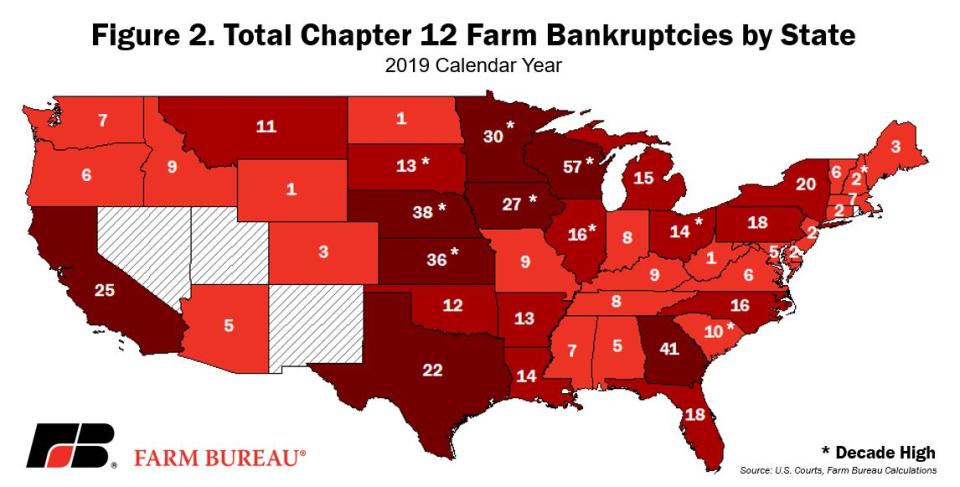U.S. farm bankruptcies hit an 8-year high in 2019
Although farmers were able to celebrate the passage of the USMCA and signing of a phase one U.S.-China trade deal, many are still facing an existential crisis.
According to U.S. Courts data, U.S. farm bankruptcy rates increased by 20% in 2019, an eight-year high. There were a total of 595 Chapter 12 bankruptcies filed by family farmers.
“A lot of the bankruptcies have been on the dairy side of life and there have been a lot of mitigating impacts going on there,” Veronica Nigh, senior economist for the American Farm Bureau, recently told Yahoo Finance.

‘Large amounts of debt’
Wisconsin, the heart of the dairy industry, saw 57 farm bankruptcies, its highest level in a decade. Over the past 15 years, there's been a 49% decrease in the number of dairy farms in the state. And between 2016 and 2018, Wisconsin lost almost 1,200 dairy farms.
“Milk prices have been low for a number of years,” John Newton, chief economist for the American Farm Bureau, recently told Yahoo Finance. “When you think of the capital requirements to run an operation, small- and medium-sized dairy operations find themselves with large amounts of debt. Several years of low commodity prices and the large amounts of debt are really contributing to the rise of Chapter 12 bankruptcies we see in key dairy producing regions.”

Newton explained that in the longer term, the issues with the dairy industry are surrounding how to balance supply and demand, stating that it can take a long time for the dynamics to rebalance.
“In 2014, we had record high milk prices and dairy farmers in the U.S. expanded output, and farmers around the world expanded output,” Newton said. “We’ve really been in a 4-5 year hangover trying to get rid of excess supply. We’re finally moving from a global milk supply situation of oversupply to one that’s a little bit tighter.”
Competition in the beverage milk space isn’t helping either, as more people are turning to plant-based beverages.
“When you see the biggest milk processors, Borden and Dean Foods, go bankrupt, we’re kind of at an inflection point with respect to the fluid milk business,” Newton said.
The passage of the USMCA is expected to help at least some of the dairy industry.
“Because there's a lot of other things going on, it seems unlikely that one part of that puzzle will solve the whole puzzle but it certainly helps,” Nigh said.

‘Nobody’s made whole from this’
Newton said that the next step is to see what happens with respect to China, now that a phase one trade deal is in place.
“We’re likely to have one of the smallest trade surpluses in agriculture in the last four decades because of slower agriculture exports we experienced in 2019,” he said.
In order to help offset the effects of retaliatory tariffs from China, the U.S. Department of Agriculture (USDA) provided farmers with market facilitation payments. According to the USDA, nearly one-third of farm income in 2019 came from government aid.
“Farmers and ranchers didn’t ask to be unfairly retaliated against,” Newton said. “Nobody’s made whole from this. They’d rather have trade, not aid.”
Adriana is an associate editor for Yahoo Finance. She can be reached at [email protected]. Follow her on Twitter @adrianambells.
READ MORE:
'Losing two farms a day': Wisconsin is facing a serious dairy crisis
Farmer: Trump's $28 billion bailout isn't worth the trade war
Trade war: New analysis updates staggering amount Americans pay for Trump's tariffs
Read the latest financial and business news from Yahoo Finance
Follow Yahoo Finance on Twitter, Facebook, Instagram, Flipboard, SmartNews, LinkedIn, YouTube, and reddit.
